Creating a Revolve | ||||
|
| |||
Click any icon requiring a shape definition. For example, launch the Shellable capability
 ,
then click Revolve
,
then click Revolve
 in the Shellable Feature dialog box that appears.
in the Shellable Feature dialog box that appears.All the shape features have a Profile/Surface as part of the prism geometry definition. You can select an existing sketch or surface as a Profile/Surface of the Prism definition. If you launch the command with no profile previously defined, you can access to the Sketcher by clicking the icon
 available in the dialog box and sketch the profile you need.
available in the dialog box and sketch the profile you need.Important: - If you launch the command with no profile previously
defined, click Sketcher
 sketch the profile you need.
sketch the profile you need. - You can also select:
- Any face originated by functional features of any Solid Functional Set. In this case, the face needs to be the original untrimmed (unmerged) of the feature.
- Any topological (trimmed) face of any Part Design body that is not the Part Body containing the active Solid Functional Set.
You can also select any face originated by functional features of any Functional Body. In this case, the face needs to be the original untrimmed (unmerged) of the feature.
You can also select any topological (trimmed) face of any Part Design body that is not the Part Body containing the active Solid Functional Set.
- If you launch the command with no profile previously
defined, click Sketcher
Select the profile you want to revolve.
By default, the application specifies the length of your revolve feature and previews limits. LIM1 corresponds to the first angle value, and LIM2 corresponds to the second angle value.
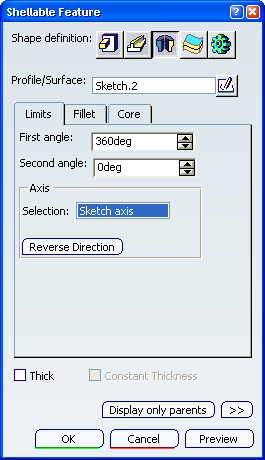
The first angle value is by default 360 degrees. Enter the value of your choice in the First angle field if you want to define a different angle value. For example, enter 100 degrees.
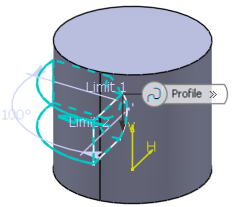
Enter the value of your choice the Second angle box to define the second angle value.
The Selection field in the Axis frame is reserved for the axes you explicitly select.
Clicking the Reverse Direction button reverses the extrusion direction. Another way of reversing the direction is by clicking the arrow in the geometry area.
Select the Thick check box. This option enables you to add material to both sides of the profile.
- If you enter 5mm in the Inside Thickness
field and click Preview. Thickness is evenly distributed to both sides of the profile.
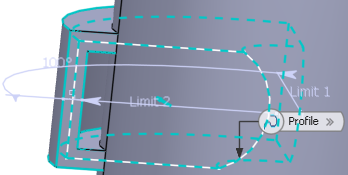
If you select Outside Thickness in the Reference list and click Preview. The thickness you defined for Inside Thickness is added to the inside of the profile.
If you enter 3mm in the Outside Thickness box. The application previews how the thickness is added to the outside of the profile.
- If you enter 5mm in the Inside Thickness
field and click Preview. Thickness is evenly distributed to both sides of the profile.
Click the Fillet tab.
Select the Lateral radius check box if you want to fillet lateral edges. Then, you merely need to set the radius value of your choice.
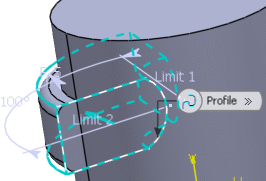
Select the First radius check box if you wish to fillet top edges. Then, set the radius value of your choice.
Select the Second radius check box if you want to fillet the opposite bottom edges. Then, set the radius value of your choice.
Select the Constant Thickness check box. This option allows you to apply lateral fillets to the feature with a constant wall thickness.
- If you select Neutral Fiber in the Reference list, lateral fillet radius is applied at neutral fiber.
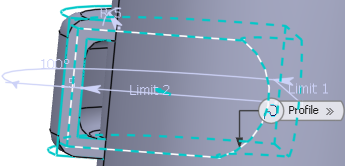
If you select Outside Thickness in the Reference list, lateral fillet radius is applied at outside thickness face.
If you select Inside Thickness in the Reference list, lateral fillet radius is applied at Inside thickness face.
Note: For more information, see More About Thick Option.
Important: The Core capability enables you to define a core body (offset) for a shellable feature. - If you select Neutral Fiber in the Reference list, lateral fillet radius is applied at neutral fiber.